Studio Electronics Tonestar 2600 – Eurorack Synth – Voice Review
Studio Electronics has created a great stir with its Boomstar range, but now the Tonestar 2600 enters the arena, in Eurorack format. Dave Gale patches up this new semi-modular… Details Kit Tonestar 2600 – Eurorack Synth-Voice Manufacturer Studio Electronics Price £449 (RRP) Contact MSL Professional 0207 118 0133 contact@mslpro.co.uk, www.studioelectronics.com If you had to ask the […]

Studio Electronics has created a great stir with its Boomstar range, but now the Tonestar 2600 enters the arena, in Eurorack format. Dave Gale patches up this new semi-modular…
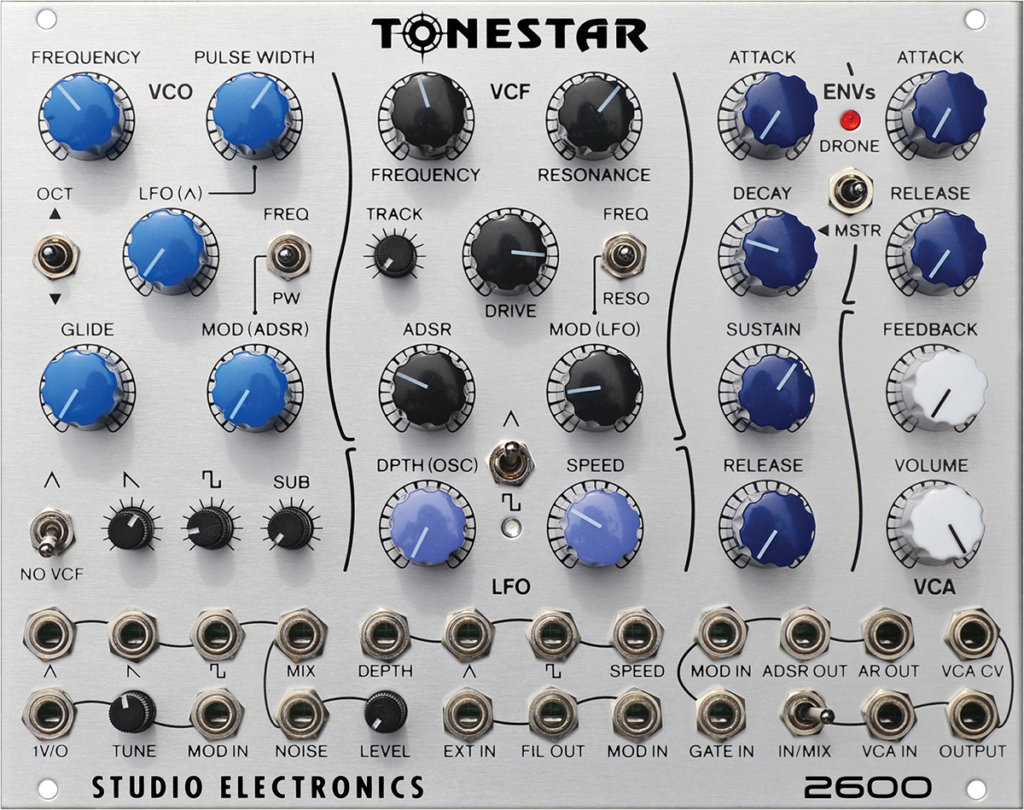

Details
Kit Tonestar 2600 – Eurorack Synth-Voice
Manufacturer Studio Electronics
Price £449 (RRP)
Contact MSL Professional 0207 118 0133 contact@mslpro.co.uk, www.studioelectronics.com
![]()
If you had to ask the question: “What product seemed to be the most prevalent at the recent round of music-tech shows?”, many would cite the seemingly new market for a Eurorack synthesiser voice in a single module.
We’ve seen the Roland System 1m, Moog Mother-32, and Pittsburgh Lifeforms, which seemed to be the first to market; and other companies, such as Oberheim, have also announced their intentions to enter the arena. But if I’m honest, the one product which has had me the most excited is the Studio Electronics Tonestar, recently appearing as the Tonestar 2600.
Why The Excitement?
I have always liked SE kit, not least of all from the perspective of build quality. The company’s products are well made, without any doubt – its motto is ‘Omne Quale Supra’ (quality above everything else), after all. There is no sense of ‘pot wobble’ with any SE products; in fact, I’d place the build quality as one of its best selling points.
However, don’t get the wrong idea here; the build quality isn’t secondary to the sound quality in any way, in fact, SE’s attention to detail in getting its modules to sound great is the main reason why the Tonestar is coming to market some months behind the likes of Roland and Moog. The guys at SE wanted to get the Tonestar 2600 just right, and then, when they thought they’d got it right, they went back and listened and tinkered, until it was even more right…
The Tonestar Structure
Enough of my excitement – let’s dive in and have a look at what we have in the way of an architecture.
Starting at the front end, we have a VCO, which many will not be surprised to learn offers almost identical functionality to the SE Oscillations module. For my money, the Oscillations is one of the best of the current crop of Eurorack VCOs. Its stability in both tuning and tracking coupled with great-sounding source waveforms has set the bar pretty high and I’m delighted to report that the Tonestar follows suit, tracking up to a full eight octaves.
The only waveform not on offer here that is present on the Oscillations is a sine, which is hardly the most important of waveforms to include. However, there is a nifty little switch which bypasses the triangle wave from the filter, meaning that the fundamental stays true.
There’s a healthy amount of control of parameters, with an excellently wide and sensitive PWM to apply to your square/pulse wave; and this can be routed from both LFO and Envelope sources, for control from within the single module. The one addition which I did wish had made it onto the Oscillations is the Octave switch, which nestles just below the fully sweepable frequency control on the Tonestar.
It’s easy to flick between three octaves with this switch, which is something you may well find yourself doing as soon as you turn up the sub oscillator. Yes, that’s right! It’s even got a square-wave sub, which is something the Moog Mother-32 doesn’t have, and for me was something of an omission. Lurking at the bottom, you will also find a small volume pot which relates to white noise, keeping it out of the way of more tonal duties, which are the centre of the main VCO section.
I wanted to know exactly how close to the Oscillations the Tonestar source tones actually are. So, with both modules powered up, I did the obligatory A/B test. To my ears, I couldn’t hear any difference at all, which I can’t say is an enormous surprise, but it’s helpful to have these things confirmed. I’ve always found the saw on the Oscillations to have some ‘heft’ in tonal quality. It just seems to have plenty of depth in its purest form, so I was delighted to find that the Tonestar saw wave offered the same weight, when unfiltered and pure.
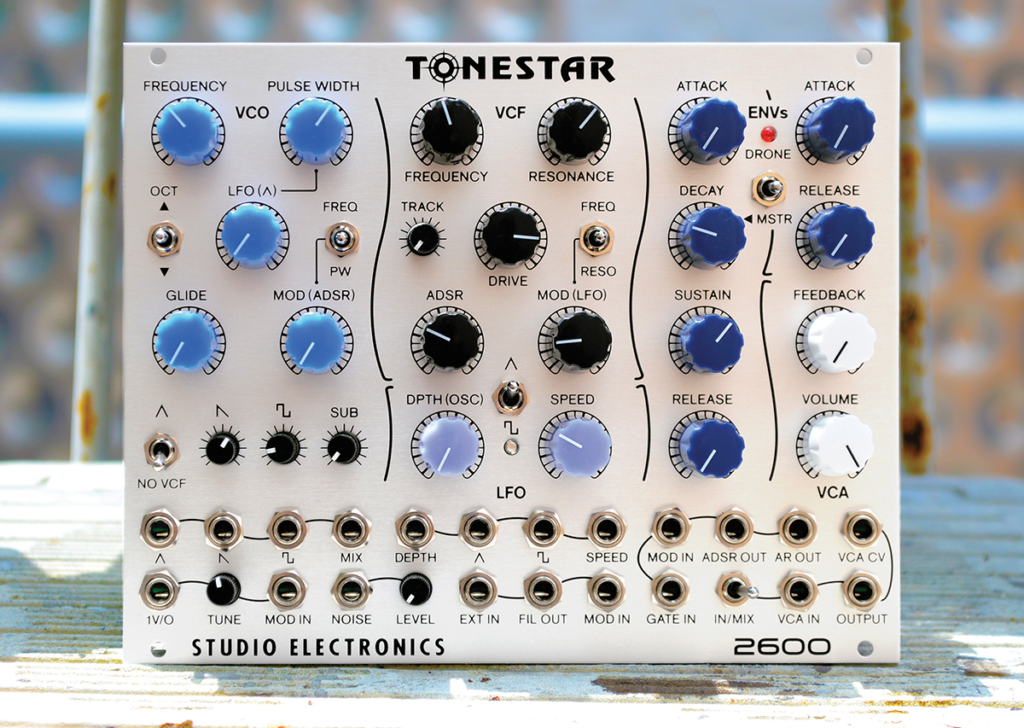
Nice ‘n’ easy VCO on the left, Filter and LFO in the middle and VCA/Envelopes to the right, not forgetting all the helpful patch points at the bottom.
Moving forward, we next encounter the Filter section. When SE first released its Boomstar series of synths, it was the filters that made all the difference. The series offered the same synth in five different colours, with the only factor that altered from model to model being the filter, so when it came to the filter choice for the Tonestar, SE decided to plump for the ARP-style 4075 filter.
Yet it turns out that with the extraordinary attention to detail that these guys have, they started pulling out loads of original ARP synths to tinker with, in order to tune the filter into something even more bespoke. It turns out that SE mistakenly named its 4075 filter – it should have been a 4072 filter (no, I wouldn’t have known this either).
So, with my A/B hat on, I found myself switching from a 4075 module to the Tonestar filter. Again, there were no really discernible differences here, until you reached the point of overdrive. The 4075 module overdrives as the Input pot is increased, whereas the Tonestar has an exceptionally useful Drive pot which adds another dimension – one which I’d have liked to have seen on my original 4075 filter. It’s also possible that this change in circuit contributes to the slightly different tonal colour.
If you really pushed me to pick one, I’d say that the 4075 module just had the edge, feeling a shade more gutsy, though I do still like the Tonestar’s filter overdrive. Key tracking is also available, via a tuneable pot, which, when turned up fully, tracks to 100 per cent.
With the resonance cranked, nice tuned resonant timbres tracked with a minimum of hassle, and without any of the wobble that can often be the case on analogue modules with tracking available. It’s also worth pointing out here that many more traditional filters, such as the Moog ladder design, suffer a drop in both level and bottom end when the resonance control is cranked, and that is the case here.
It’s not as pronounced, but what really makes the difference is, as you turn up the overdrive, the bottom end falls back into place. Though it’s with additional tonal colour, it’s still a really helpful feature when trying to make up that monster bass patch with a hint of resonance.
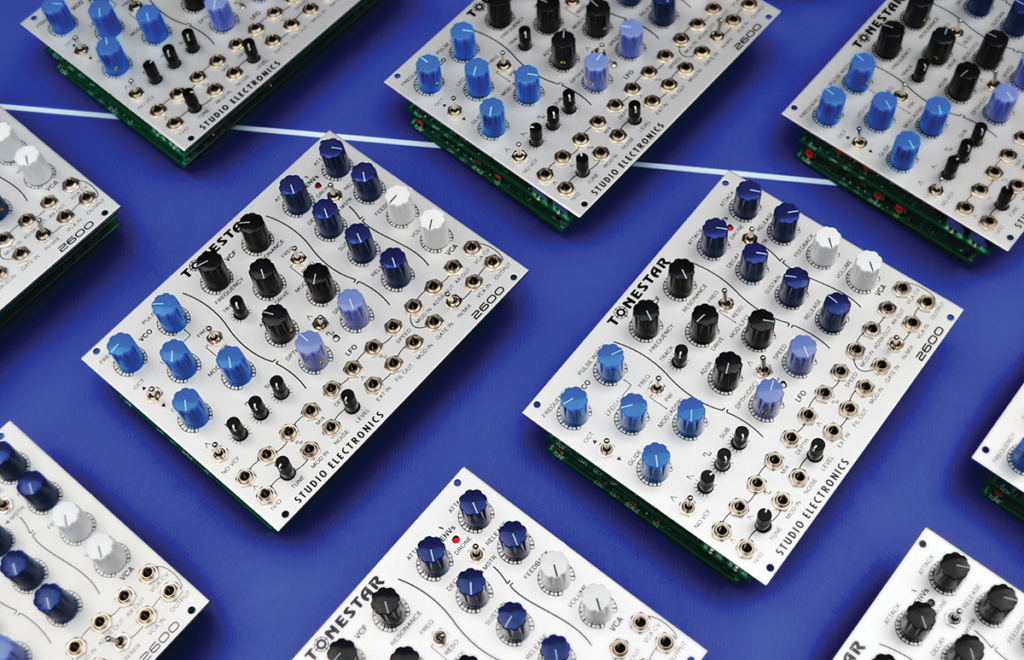
What could be better than one Tonestar 2600? How about a whole bunch of them?
Following on, we have the Envelope section. What could be interesting about that, you ask? Well, there are two of them for a start – the first envelope is a full-blown ADSR envelope, and the second is a simplified Attack/Release affair, with options for switching duties, so you can assign the relevant envelope according to the patching you require. This is a masterstroke, and another ‘one-up’ over the Mother-32, which has a very simplistic envelope, and only the one.
So, immediately, there’s a whole world of amplitude and other routing options available to the user. With even more attention to detail, the primary envelope mimics a minor glitch that appeared on the ARP 2600 and Odyssey, where, after the initial decay, the sustain ‘sinks’ and moves. SE cites this as a flaw in the original ARP circuit, but it’s also part of the charm of the original, which offers up a slightly musical quality: and for me, it’s these little moments that add to the charm of a great synth.
The dedicated LFO section offers a number of options for routing, drawing on triangle and square waveforms for modulation. Switched routing can be achieved to both frequency and
pulse width on the VCO, or sent in the direction of frequency and – more uniquely – resonance, on the VCF.
In both instances, there are dedicated Amount pots that allow for fine-tuning of level. Soon enough, delicious Juno-style PWM chorus-type effects emanate, making you wish you had polyphony available. The LFO will also head up into the audio spectrum, if so desired.
Glide is available to slew between pitch CVs and, on the back end, there is a dedicated pot labelled ‘feedback’. I’d wager that this is a far cry from the old feedback loops that were popular on classic Minimoogs, though certainly the beautiful colours that start to appear are reminiscent of this. Bear in mind that this also sits alongside the filter overdrive, which is a slightly different beast, so, for distortion, the user is spoilt for choice. Finishing off the signal chain is a VCA volume control, which can head straight out into the real world, without needing further modules.
And finally, it wouldn’t be a Eurorack module if it didn’t have all the patch points, and there are plenty, including a rather handy external input which heads right into the filter. The usual array of outs is available from the VCO, but for the most part, everything that you need to operate a single synth-voice is hard wired and ready to go, so for many, the patch points will primarily serve signals coming out into the rest of a modular. It’s a great resource for this sort of purpose, and very helpful in a smaller rig as a result.
Flow Diagrams
Being of the generation that grew up with the onslaught of the Japanese machines, I have always been well versed with the purity and uncluttered signal flow associated with the Roland machines of the early 80s, and the Tonestar reminds me of this. It’s logically laid out: simple, but with the odd switch requiring greater thought.
Getting into the nitty gritty of patching, the Tonestar is a real breeze to work with. You just dive in and get your hands dirty. It’s funny how, with Eurorack, you always find yourself wanting more, and I did reach for a patch cable or two in order to hook up my Oscillations alongside the Tonestar, so that I could detune the primary VCOs, with the sub nestling below.
The raw waveforms are full of body; I especially like the saw on the Tonestar, which somehow feels full of depth compared to other saws I have in my rig, but it’s the filter that I feel lends the real charm. ARP filters are legendary, and this reincarnation is a thing of beauty.
It sounds so classy and crisp, with a resonance that really sings out – and here, I have to mention again the wonderful ability to control the resonance from the LFO. It’s a unique feature in modules of this kind and adds yet more character to the Tonestar, but moreover, the drive on the filter adds character by the bucketload.The resonance shouts under these conditions and breaks through the heaviest of mixes, but not in the harsh way that some digital filters might.
Tonestar needs a Home
The only negative point that I can think of for this module is that when you buy one, you only get a module. This is fine if you already have a Eurorack, or you’re starting out with an eye on the bigger picture – so if the latter describes you, I would consider this unit to be a great starting point to go in a skiff or small case; you’ll need the housing, and some power, but that’s it! Skiffs or 1U cabinets start at around the £120 mark, so perhaps look at the Low Cost Doepfer designs (LC-3) as a starting point. You may want to add another oscillator at some point, too, so you could consider partnering this with an SE Oscillations.
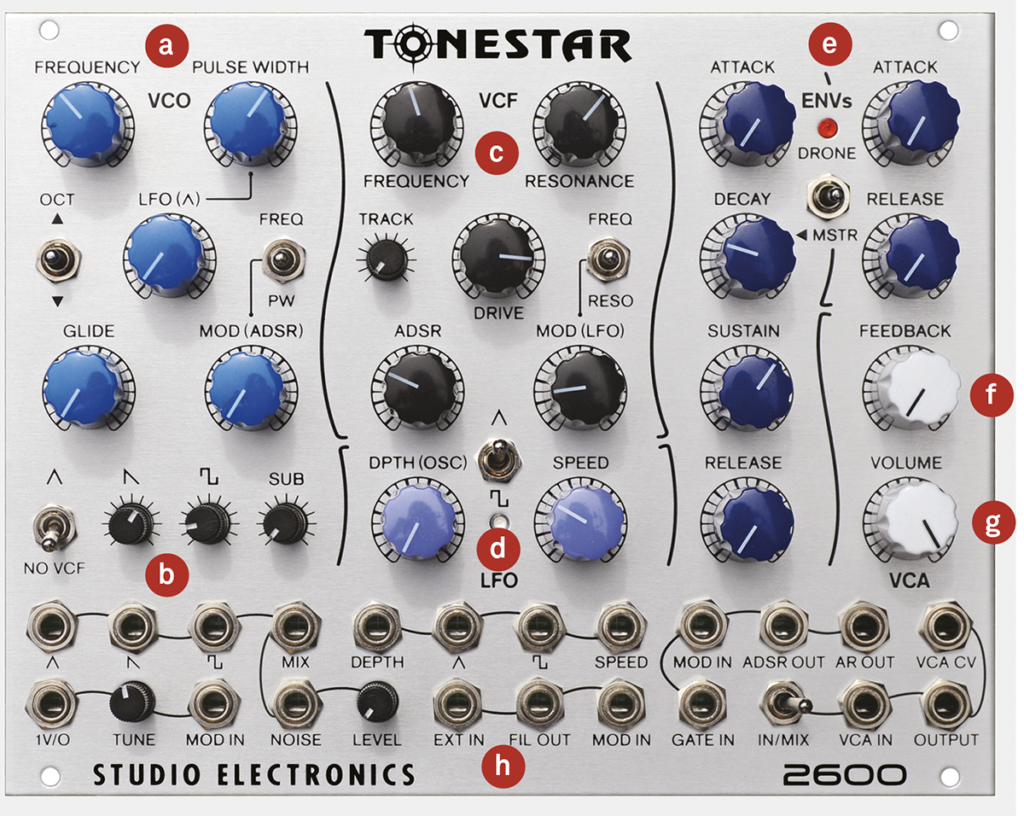
a: VCO section
The VCO section, with frequency control and octave switch. Pulse width modulation is assignable to either LFO or Envelope, according to switch position.
b: MIXER SECTION
The mixer section allows the user to combine just the right amount of each waveform, including the Sub. The result sums from the Mix out.
c: ARP FILTER
The outstanding ARP-based filter, complete with overdrive. The tracking pot assures 100-per-cent tracking when fully rotated.
d: LFO WAVEFORMS
Tucked away at the bottom, the LFO is switchable between triangle and square wave, with the obligatory speed and depth controls.
e: ADSR AND AR
Two envelopes for the price of one! A full ADSR envelope resides alongside a simpler AR design, but duties can be re-assigned by both switching and patch field.
f: FEEDBACK LOOP
The feedback loop; a far cry from the cable-out-of-the-headphone ‘Moog’ trick, this pot places the control right where it needs to be.
g: PUMP UP THE VOLUME
A fully formed volume control, outputting the Tonestar to the real world, without any need for further modules. Patch from the Out socket for audio nirvana!
h: INS AND OUTS
No slouching on the patch field, either. The world is at your disposal, with plenty of options to send signals in and out of your own Eurorack.
Alternatives
There are lots to choices in the single-voice Eurorack market at present, many of which we have already reviewed in MusicTech.
The Roland System-1m is a great digital incarnation; however, the obvious bedfellow is the Moog Mother-32. They are different synths, but as a synth-voice, the Tonestar offers more sonic possibilities, straight out of the box. The Moog is wonderful, comes in a lovely ‘ready-to-go’ package and has an onboard sequencer (which is admittedly a shade tricky to use).
But then the Tonestar has a sub oscillator, ARP-based filter and two envelopes, so it really boils down to whether you want something that sounds like a Moog, or more like an ARP. It’s a tough choice to make, and both modules are very valid and exceptionally good – but for me, I think the Tonestar just has the edge, purely on available functionality. Plus, it’s £50 cheaper, but you will need a case to put it in.
Do I really need this?
The Tonestar 2600 represents absolutely fantastic value for money. You’re essentially getting the guts of the SE Oscillations and 4075 filter in one hit, along with all the othern elements thrown in for good measure. So if you’re new to Eurorack, this is a worthy contender for your first purchase.
You’ll need some form of interface or sequencer to drive it, and a case to put it in – but the quality of the product speaks for itself, both physically and sonically. This would be ideal for a smaller rig, where space is at a premium.
Conclusion
Sonically, this is not designed to be some kind of straightahead clone of a 2600 – which is odd, when you consider that SE has elected to name it the Tonestar 2600.
This begs the question as to whether we’ll eventually see further modules appearing with different filters, as with the Boomstar series… but if this is the case, I’m delighted that this ‘ARP’ incarnation is the first to see the light of day. It’s a beautifully colourful module, with one of the best filters around, not to mention one of the finest VCOs. It’s very well built, solid as a rock, and is as stable as you like. If only all modules were built this way.
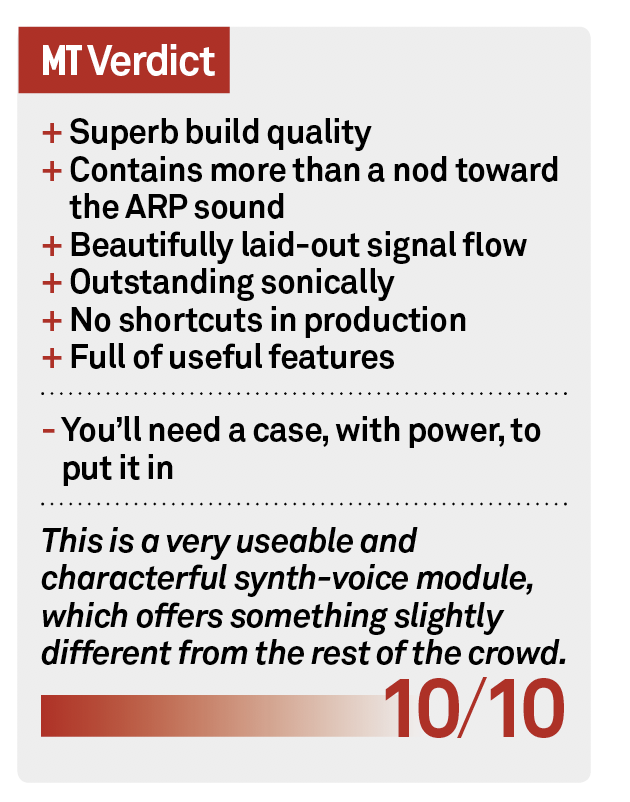
Key Features
● Full single-voice format
● Analogue architecture
● Draws inspiration from ARP synth designs
● Width: 32HP
● Current draw: 120mA
● Hardwired for convenience
● Plenty of patch points available


